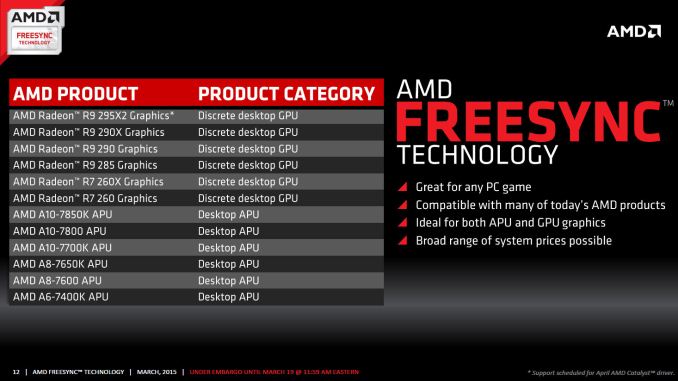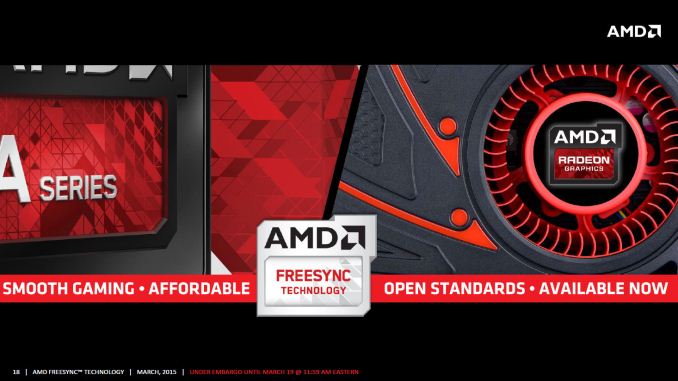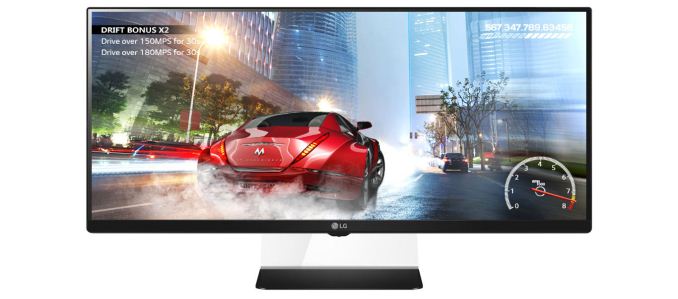The AMD FreeSync Review
by Jarred Walton on March 19, 2015 12:00 PM ESTClosing Thoughts
It took a while to get here, but if the proof is in the eating of the pudding, FreeSync tastes just as good as G-SYNC when it comes to adaptive refresh rates. Within the supported refresh rate range, I found nothing to complain about. Perhaps more importantly, while you’re not getting a “free” monitor upgrade, the current prices of the FreeSync displays are very close to what you’d pay for an equivalent display that doesn’t have adaptive sync. That’s great news, and with the major scaler manufacturers on board with adaptive sync the price disparity should only shrink over time.
The short summary is that FreeSync works just as you’d expect, and at least in our limited testing so far there have been no problems. Which isn’t to say that FreeSync will work with every possible AMD setup right now. As noted last month, the initial FreeSync driver that AMD provided (Catalyst 15.3 Beta 1) only allows FreeSync to work with single GPU configurations. Another driver should be coming next month that will support FreeSync with CrossFire setups.
Besides needing a driver and FreeSync display, you also need a GPU that uses AMD’s GCN 1.1 or later architecture. The list at present consists of the R7 260/260X, R9 285, R9 290/290X/295X2 discrete GPUs, as well as the Kaveri APUs – A6-7400K, A8-7600/7650K, and A10-7700K/7800/7850K. First generation GCN 1.0 cards (HD 7950/7970 or R9 280/280X and similar) are not supported.
All is not sunshine and roses, however. Part of the problem with reviewing something like FreeSync is that we're inherently tied to the hardware we receive, in this case the LG 34UM67 display. Armed with an R9 290X and running at the native resolution, the vast majority of games will run at 48FPS or above even at maximum detail settings, though of course there are exceptions. This means they look and feel smooth. But what happens with more demanding games or with lower performance GPUs? If you're running without VSYNC, you'd get tearing below 48FPS, while with VSYNC you'd get stuttering.
Neither is ideal, but how much this impacts your experience will depend on the game and individual. G-SYNC handles dropping below the minimum FPS more gracefully than FreeSync, though if you're routinely falling below the minimum FreeSync refresh rate we'd argue that you should lower the settings. Mostly what you get with FreeSync/G-SYNC is the ability to have smooth gaming at 40-60 FPS and not just 60+ FPS.
Other sites are reporting ghosting on FreeSync displays, but that's not inherent to the technology. Rather, it's a display specific problem (just as the amount of ghosting on normal LCDs is display specific). Using higher quality panels and hardware designed to reduce/eliminate ghosting is the solution. The FreeSync displays so far appear to not have the same level of anti-ghosting as the currently available G-SYNC panels, which is unfortunate if true. (Note that we've only looked at the LG 34UM67, so we can't report on all the FreeSync displays.) Again, ghosting shouldn't be a FreeSync issue so much as a panel/scaler/firmware problem, so we'll hold off on further commentary until we get to the monitor reviews.
One final topic to address is something that has become more noticeable to me over the past few months. While G-SYNC/FreeSync can make a big difference when frame rates are in the 40~75 FPS range, as you go beyond that point the benefits are a lot less clear. Take the 144Hz ASUS ROG Swift as an example. Even with G-SYNC disabled, the 144Hz refresh rate makes tearing rather difficult to spot, at least in my experience. Considering pixel response times for LCDs are not instantaneous and combine that with the way our human eyes and brain process the world and for all the hype I still think having high refresh rates with VSYNC disabled gets you 98% of the way to the goal of smooth gaming with no noticeable visual artifacts (at least for those of us without superhuman eyesight).
Overall, I’m impressed with what AMD has delivered so far with FreeSync. AMD gamers in particular will want to keep an eye on the new and upcoming FreeSync displays. They may not be the “must have” upgrade right now, but if you’re in the market and the price premium is less than $50, why not get FreeSync? On the other hand, for NVIDIA users things just got more complicated. Assuming you haven’t already jumped on the G-SYNC train, there’s now this question of whether or not NVIDIA will support non-G-SYNC displays that implement DisplayPort’s Adaptive Sync technology. I have little doubt that NVIDIA can support FreeSync panels, but whether they will support them is far less certain. Given the current price premium on G-SYNC displays, it’s probably a good time to sit back and wait a few months to see how things develop.
There is one G-SYNC display that I’m still waiting to see, however: Acer’s 27” 1440p144 IPS (AHVA) XB270HU. It was teased at CES and it could very well be the holy grail of displays. It’s scheduled to launch next month, and official pricing is $799 (with some pre-orders now online at higher prices). We might see a FreeSync variant of the XB270HU as well in the coming months, if not from Acer than likely from some other manufacturer. For those that work with images and movies as well as playing games, IPS/AHVA displays with G-SYNC or FreeSync support are definitely needed.
Wrapping up, if you haven’t upgraded your display in a while, now is a good time to take stock of the various options. IPS and other wide viewing angle displays have come down quite a bit in pricing, and there are overclockable 27” and 30” IPS displays that don’t cost much at all. Unfortunately, if you want a guaranteed high refresh rate, there’s a good chance you’re going to have to settle for TN. The new UltraWide LG displays with 75Hz IPS panels at least deliver a moderate improvement though, and they now come with FreeSync as an added bonus.
Considering a good display can last 5+ years, making a larger investment isn’t a bad idea, but by the same token rushing into a new display isn’t advisable either as you don't want to end up stuck with a "lemon" or a dead technology. Take some time, read the reviews, and then find the display that you will be happy to use for the next half decade. At least by then we should have a better idea of which display technologies will stick around.













350 Comments
View All Comments
5150Joker - Friday, March 20, 2015 - link
NewEgg review LOL! In defense of Jared, he's probably working in the confines of the equipment made available to him by the parent company of this place. TFTCentral and PRAD have really expensive equipment they use to quantify the metrics in their reviews.chizow - Thursday, March 19, 2015 - link
G-Sync isn't going anywhere, but its nice to see AMD provide their fans with an inferior option as usual. Works out well, given their customers are generally less discerning anyways. Overall its a great day for AMD fans that can finally enjoy the tech they've been downplaying for some 18 months since G-Sync was announced.Black Obsidian - Thursday, March 19, 2015 - link
AMD offers an option that's indistinguishable in actual use from nVidia's, and significantly cheaper to boot. Sure, it's not enough for the "discerning" set who are willing to pay big premiums for minuscule gains just so they can brag that they have the best, but who other than nVidia stockholders cares who gets to fleece that crowd?Frankly, I wish that AMD could pull the same stunt in the CPU market. Intel could use a price/performance kick in the pants.
chizow - Thursday, March 19, 2015 - link
Well unfortunately, for less discerning customers, the type that would just take such a superficial review as gospel to declare equivalency, the issues with input lag focuses on minor differences that were not easily quantified or identified, but over thousands of frames, the differences are much more apparent.If you're referring to differences in FPS charts, you've already failed in seeing the value Nvidia provides to end-users in their products as graphics cards have become much more than just spitting out frames on a bar graph. FreeSync and G-Sync are just another example of this, going beyond the "miniscule gains" vs price tag that less discerning individuals might prioritize.
Ranger101 - Friday, March 20, 2015 - link
My heartfelt thanks to chizow. Your fanboy gibberings are a constant source of amusement :)chizow - Friday, March 20, 2015 - link
Np, without the nonsense posted by AMD fanboys there wouldn't be a need to post at all!Black Obsidian - Friday, March 20, 2015 - link
You're so discerning that I'm sure you could wax poetical on how your $3K monocrystalline speaker cables properly align the electrons to improve the depth of your music in ways that aren't easily quantifiable.chizow - Friday, March 20, 2015 - link
No, but I can certainly tell you why G-Sync and dozen or so other features Nvidia provides as value-add features for their graphics cards make them a better solution for me and the vast majority of the market.silverblue - Friday, March 20, 2015 - link
A dozen? Please.No really, I mean PLEASE tell us this "dozen or so other features".
chizow - Friday, March 20, 2015 - link
Np, always nice mental exercise reminding myself why I prefer Nvidia over AMD:1. G-Sync
2. 3D Vision (and soon VRDirect)
3. PhysX
4. GeForce Experience
5. Shadowplay
6. Better 3rd party tool support (NVInspector, Afterburner, Precision) which gives control over SLI/AA settings in game profiles and overclocking
7. GameWorks
8. Better driver support and features (driver-level FXAA and HBAO+), profiles as mentioned above, better CF profile and Day 1 support.
9. Better AA support, both in-game and forced via driver (MFAA, TXAA, and now DSR)
10. Better SLI compatibility and control (even if XDMA and CF have come a long way in terms of frame pacing and scaling).
11. Better game bundles
12. Better vendor partners and warranty (especially EVGA).
13. Better reference/stock cooler, acoustics, heat etc.
Don't particularly use these but they are interesting to me at either work or in the future:
14. CUDA, we only use CUDA at work, period.
15. GameStream. This has potential but not enough for me to buy a $200-300 Android device for PC gaming, yet.
16. GRID. Another way to play your PC games on connected mobile devices.
Damn, was that 16? No sweat.